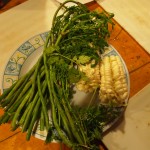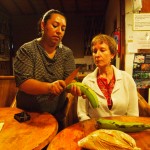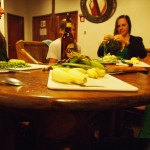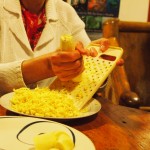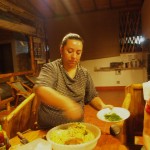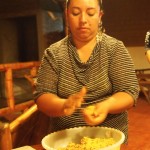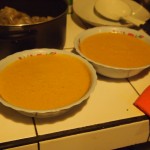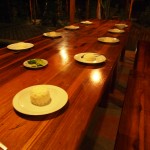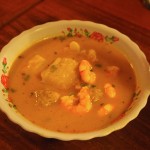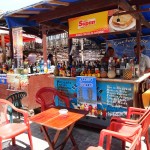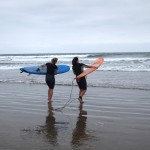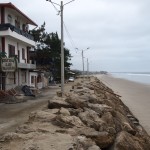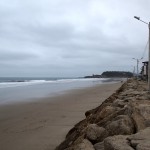On Wednesday last week, Verenice, our Spanish teacher at the school, came over to the cabañas to give us a cooking lesson. We made a traditional ecuadorian dinner — camarones sopa (shrimp soup), with a peanut-based broth and plantain “meatballs”.
The pictures below speak for themselves, but the group of us had a blast preparing all of the fresh food. I’d never shredded plantains before — they looked like a strange plate of scrambled eggs, or some sort of mushy shredded cheese — but they tasted delicious mixed with spices, a special spiced oil, and fresh cilantro. We shaped the mixture into balls, then them cooked right in the soup broth.
Verenice blended the peanut paste (peanut butter is apparently expensive and hard to obtain in Ecuador) with water in a blender to make it thinner and smoother, then put the liquid into a pot of boiling water, flavored with yuca, a white root-like vegetable that could be called an Ecuadorian potato, onion, and garlic. Then we added the plantain balls and our shrimp, plus a ton of spices. After twenty minutes, the soup was done and we dug in.
Verenice served the soup with arroz (rice), which was a perfect compliment. I’m not a huge peanut butter fan, so I could have done without the broth, but I loved all of the contents of the soup, a strange but totally delicious combination.
Arroz is a staple in South America, but especially in Ecuador. A typical plato consists of camaron, pescado (fish), or pollo served with rice and a coleslaw-type salad. In towns like Moñtanita that are right on the water, seafood is the freshest, most delicious option. All along the main road in town are ceviche stands, with men waiting to serve you fresh clams, mussels, shrimp and fish in delicious lemon sauce concoctions.
- I didn’t bring my camera out at night, but here is one of the main cocktail stands during the day.
On Friday night, I experienced the Calle de Cocteles of Moñtanita. One of the main streets of town, and the only one with a name, is lined with dozens of small carts, each boasting bottles and bottles of booze, baskets of fresh fruit and blenders. For as little as $2.50, your personal bartender, who will fist pump with you, kiss your cheeks and personally arrange a plastic chair on the street for you to sit in, will concoct any sort of fruit and alcohol mixture you can dream of.
We had maracuya, which is a local passionfruit, blended with rum, topped with a strawberry. Our group sat chatting and watching the wide variety of crazy tourists walk back and forth along the “strip” — a 50 yard section of the street with dance clubs, bars, and alcohol carts that dead ends at the beach.
After drinking on the street (flashbacks to Ho Hai in Beijing where we walked around the streets with beer bottles in our hands) we headed into the Caña Grill, a favorite bar in town where they have a sand floor, $2 mojitos and a live band every night. I don’t typically like to go out and party when I’m traveling alone, and unlike a lot of travelers in SA, partying is far from the reason I’m on the road. But since I’d spent the week getting to know all the other students at the school, and quickly became close with Kathleen, Katarina, and Chloe, I felt comfortable letting loose a bit and going out, especially since it was our last night altogether before many of us went our separate ways.
The number of Ecuadorian men who tried to dance with our group of girls was laughable — as one of the British guys in our group said, there were busloads — but I had a blast getting my salsa on and jamming to some old American pop and RnB. I felt in control and safe the entire time, surrounded by some amazing other world travelers who, like me, were also exercising their new Spanish skills to tell our newfound friends where they were from and what they did in the ‘real world’. We danced the night away, literally, and had a blast.




